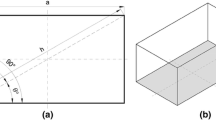Abstract
This paper presents a closed-form solution to the sag of the Cartesian oval and an alternate iterative method for obtaining the sag. The emphasis is in providing a methodology for determining the sag and derivatives of a Cartesian surface for optical design, ray-tracing purposes. We verify our results by comparison of our solutions and by real ray tracing.






Similar content being viewed by others
References
D.E. Smith, M.L. Latham. The Geometry of Rene Descartes (Dover, 1954)
L. Siiberstein. A simplified computation of Cartesian lens surfaces. J. Opt. Soc. Am. A 25, 340–341 (1935). http://www.opticsinfobase.org/josa/abstract.cfm?uri=josa-25-10-340
H.S. Uhler. Approximations to the Cartesian oval. J. Opt. Soc. Am. A 26, 128–130 (1936). http://www.opticsinfobase.org/josa/abstract.cfm?uri=josa-26-3-128
J.D. Lawrence, A Catalog of Special Plane Curves (Dover, New York, 1972)
R. Güther. Descartes ovaloides for negative refractive indices and their aplanatic cases. Optik 119, 577–583 (2008) http://adsabs.harvard.edu/abs/2008Optik.119..577G
MATHEMATICA, Wolfram Research Inc., Champaign Ill., http://www.wolfram.com
R.B. King. Beyond the Quartic Equation, Chapter 5 (Birkhäuser, Boston, 1996) http://www.springerlink.com/content/vt24414163452218/
R.W.D. Nickalls. A new approach to solving the cubic: Cardan’s solution revealed. The Mathematical Gazette 77, 354–359 (1993) http://www.2dcurves.com/cubic/solving%20the%20cubic.pdf
O.N. Stavroudis, Modular Optical Design (Springer, New York, 1982)
Acknowledgements
The first author especially thanks Professor Psang Dain Lin, Professor Jose Sasian, and the National Science Council (NSC) of Taiwan for the opportunity to do research at the College of Optical Sciences at the University of Arizona under NSC grant number NSC98-2917-I-006-108.
Author information
Authors and Affiliations
Corresponding author
Appendices
Appendix A
This appendix provides details on programming the Cartesian closed-form sag solutions:
-
Step 1:
Define π as “3.14159265358979323846”
-
Step 2:
For convention an object to the left of the surface has a negative object distance. The image distance is positive if the image is to the right of the surface.
-
Step 3:
Define the values s1, s2, n1 and n2.
-
Step 4:
Determine the coefficients A, B, C, D, and E.
-
Step 5:
Determine the coefficients α, β, and γ.
-
Step 6:
Determine the coefficients P and Q.
-
Step 7:
Determine the following parameters:
$$ \delta = \sqrt {{ - \frac{c}{{3a}}}} = \sqrt {{ - \frac{P}{{3a}}}} . $$(A1)$$ h = 2a{\delta^3} $$(A2)$$ {\theta_1} = \frac{1}{3}{\cos^{{ - 1}}}\left( { - \frac{d}{h}} \right) = \frac{1}{3}{\cos^{{ - 1}}}\left( { - \frac{Q}{h}} \right) $$(A3)$$ {{\rm v}_1} = 2\delta \cos \left( {\frac{{2\pi }}{3} - {\theta_1}} \right),\;{{\rm v}_2} = 2\delta \cos {\theta_1},\;{{\rm v}_3} = 2\delta \cos \left( {\frac{{2\pi }}{3} + {\theta_1}} \right) $$(A4)$$ y = {\rm v} - \left( {5/6} \right)\alpha $$(A5) -
Step 8:
Use Table 1 to calculate desired solution z i = (α, β, y, A, B).
Appendix B
The factors kk and ww are for controlling the algebraic signs while the conjugate distances are positive or negative. When the conjugate distance s1 is negative and the other conjugate distance s2 is positive, the factors kk and ww are given a value +1. On the other hand, these factors become −1 when the sign of s1 and s2 reverse. To avoid handling large numbers that leads to errors as they are subtracted four cases for calculating the OPL are considered.
-
Case 1: s1 ≤ 108
$$ OPL = {{\text{n}}_1}\sqrt {{{{\left( { - {s_1} + z} \right)}^2} + {r^2}}} + kk \cdot {{\text{n}}_1}{s_1}. $$(B1) -
Case 2: s1 > 108
$$ OPL = {{\text{n}}_1}\left( {z - \left( {{r^2} + {z^2}} \right)/2{{\text{s}}_1}} \right). $$(B2) -
Case 3: s2 ≤ 108
$$ OPL = {{\text{n}}_2}\sqrt {{{{\left( {{s_2} - z} \right)}^2} + {r^2}}} - ww \cdot {{\text{n}}_2}{s_2}. $$(B3) -
Case 4: s2 > 108
$$ OPL = {{\text{n}}_2}\left( { - z + ({r^2} + {z^2})/2{{\text{s}}_2}} \right). $$(B4)
where r in the four cases represents \( \sqrt {{{x^2} + {y^2}}} \) and x and y are the coordinates of intersection of a given ray.
Appendix C
The slope m x and m y of the tangent line at a given point can be calculated once the sag at that point is known as follows,
-
$$ {\text{numerator}} = \frac{{ - {n_1}{s_1}/{n_2}{s_2}}}{{s_1^2\sqrt {{{{\left( { - 1 + z/{{\text{s}}_1}} \right)}^2} + {r^2}/s_1^2}} }} + \frac{1}{{s_2^2\sqrt {{{{\left( {1 - z/{{\text{s}}_2}} \right)}^2} + {r^2}/s_2^2}} }}. $$(C1)
-
$$ {\text{denominator}} = \frac{{\left( { - {n_1}{s_1}/{n_2}{s_2}} \right)\left( { - 1 + z/{{\text{s}}_1}} \right)}}{{{s_1}\sqrt {{{{\left( { - 1 + z/{{\text{s}}_1}} \right)}^2} + {r^2}/{\text{s}}_1^2}} }} - \frac{{\left( {1 - z/{{\text{s}}_2}} \right)}}{{{s_2}\sqrt {{{{\left( {1 - z/{{\text{s}}_2}} \right)}^2} + {r^2}/{\text{s}}_2^2}} }}. $$(C2)
-
$$ {{\text{m}}_{\text{x}}}{ = } - x \cdot \frac{\text{numerator}}{{\text{denominator}}}. $$(C3)
-
$$ {{\text{m}}_{\text{y}}}{ = } - y \cdot \frac{\text{numerator}}{{\text{denominator}}}. $$(C4)
Rights and permissions
About this article
Cite this article
Hsueh, CC., Elazhary, T., Nakano, M. et al. Closed-form sag solutions for Cartesian oval surfaces. J Opt 40, 168–175 (2011). https://doi.org/10.1007/s12596-011-0050-0
Received:
Accepted:
Published:
Issue Date:
DOI: https://doi.org/10.1007/s12596-011-0050-0




